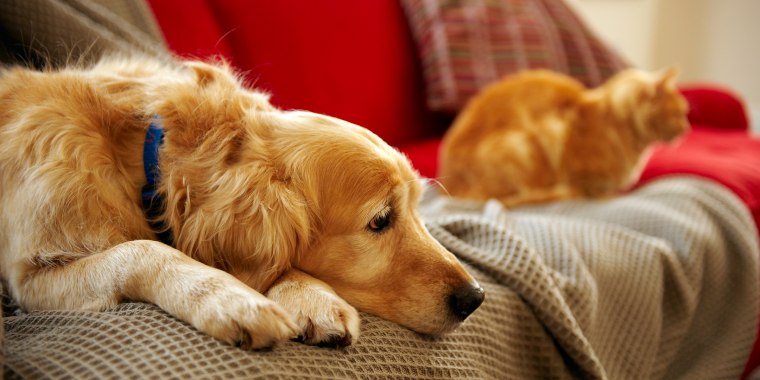As reports have surfaced about pets testing positive for the virus that causes COVID-19, public concern has grown about contact with pets. Now the Centers for Disease Control (CDC) recommends social distancing for pets, but what does that mean for our cats and dogs?
Dr. John Howe, president of the American Veterinary Medical Association, spoke with TODAY to share some rules of the road for social distancing for pets.
How scared should we be?
We can take a collective breath. “It's really not a big fear,” Dr. Howe said. “Nobody should be fearful of getting their pet sick or getting sick from their pets. There's been no documented transmission from domestic animals back to humans.” So if, say you let your dog romp around at the park last weekend with another dog, should you panic? No need, said Howe. Also reassuring: dog and cat hair is porous, he said, so it’s very difficult for viral particles to spread, unlike on smooth surfaces like countertops where the virus can just sit.
What’s the concern then?
CDC guidelines for social distancing for pets were issued out of an abundance of caution, Howe explained. “There really is not much concern around pets as far as them getting the disease or spreading it because there's only been a handful of dogs or cats in the entire world that have even mildly shown symptoms."
How can a dog test positive to begin with?
If you’ve ever met a dog you know they’re like a built-in vacuum cleaner. So “you can have dogs around somebody that's sick and they can lick droplets up off the floor if somebody sneezes,” Howe explained, “and they'll have the virus in their throat. But it doesn't mean that they're infectious. Just having the presence of the virus in their mouth doesn't really mean a thing.”
How do we follow CDC recommendations for social distancing our pets?
Here’s where you’ll be happy if you’ve invested in training. “If you're taking your dog for a walk don’t let your dog interact with other dogs,” Howe said. The same 6 foot rule applies to them as it does to us.
“And with people, same thing, don't let strangers come up and pet your dog, and don't let your dog go up and sniff strangers.” (Now’s a good time to put away those retractable leashes and keep your dog under control!) Howe also said you should avoid dog parks or any place with large congregations of people or dogs. Oh, and you don't need to put face masks on your dog. “It doesn't do any good, it's detrimental to the dog so that's not recommended,” he said.
As for cats, they shouldn’t be allowed to go in and out of the house, Howe said, so keep them inside. Not only because of the risk of COVID-19, which is low, but because "there are so many other things they can get from being inside and outside,” Howe advised.
What should you do if you’re sick and have pets?
“We should treat our pets like they're a member of the family,” Howe said. “If you have somebody else in the family that can take care of that pet while you're sick, that's recommended. If you don't, then wear a mask around the pet,” he said, and wash your hands before and after handling the pet.
What if you suspect your pet is sick, should you get it tested?
The CDC does not recommend routine testing for pets, Howe said. But call your vet, he said, if they’re showing symptoms like a runny nose, a cough, sneezing, congestion or decreased appetite.

